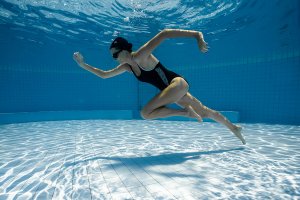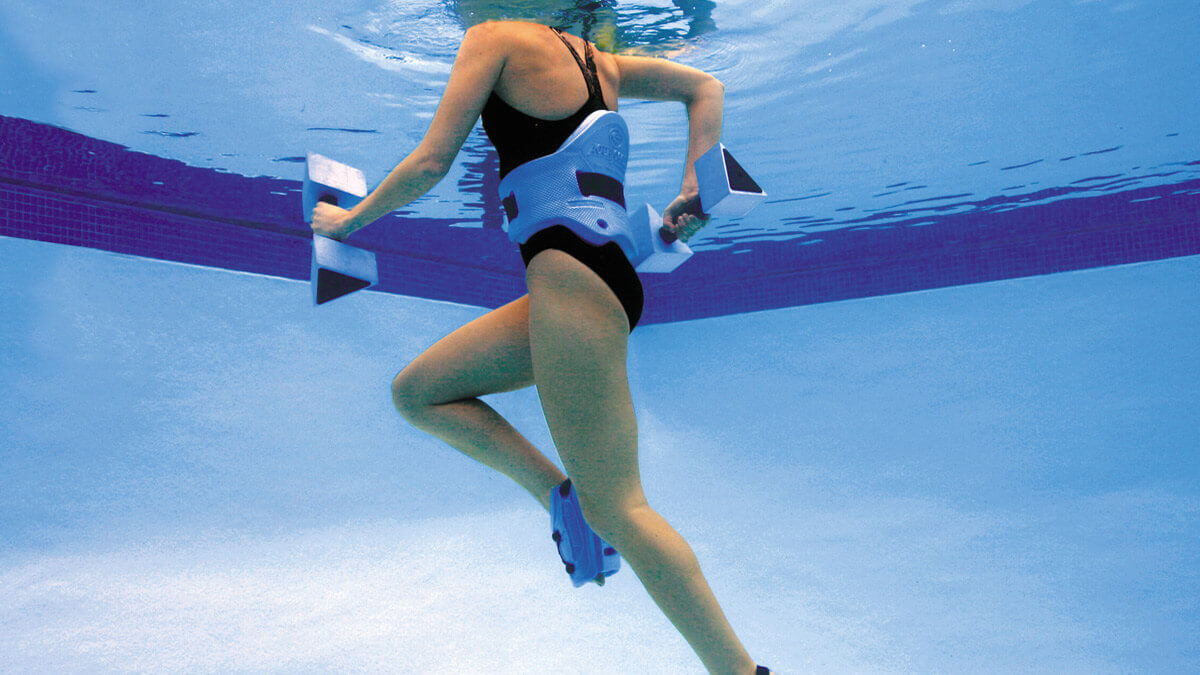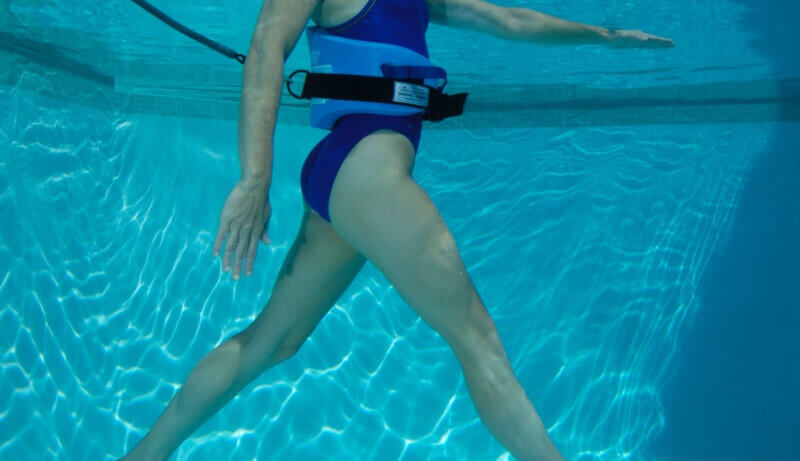Aqua Jogging: What is it and What Benefits does it Provide?

Aqua jogging could be a great element to add to your aerobic routine. It provides various advantages including preventing joint injuries since it’s a low impact workout. Aqua jogging is all about executing workouts without risk of injury.
This discipline began as a therapeutic exercise which made part of the rehabilitation process for people who had undergone surgical interventions. Now, however, it’s become a trend that anyone can practice in order to enjoy a risk-free intense physical workout.
Aqua jogging
This deepwater exercise began to be recognized as a respected training regime thanks to Olympic athlete Kelly Holmes. Before winning her bronze medal in the 2000 Sydney Olympics, the British athlete suffered an injury. It prevented her from participating in her medium distance races.
Aqua jogging helped Kelly Holmes to overcome her injury and allowed her to get fit to enjoy competing internationally. Since then, the technique of deepwater jogging was polished, allowing participants to take full advantage of its benefits.
Not only professional athletes use this method to train, but classes have also been adapted for people who simply want to improve their quality of life.
What does aqua jogging consist of?
Aqua jogging involves running moments in a state of immersion in water. The only requirement is that your feet should not touch the bottom of the pool. This training regime can also be performed in natural waters such as rivers or lakes that are deep enough.
Running, floating, without touching the ground allows for exercise without creating an impact on the joints. Keep in mind that the effectiveness of the exercise is determined by the quality of the technique and not the speed. The goal is to tone your muscles using water as resistance.

The only tool you’ll need for aqua jogging is a special belt made out of foam. The belt can be purchased over the internet and it helps to preserve the body upright allowing for proper posture and technique.
It’s true that you can float without the need for extra equipment since the air in the lungs prevents the body from sinking. However, in order to perform this aerobic exercise, you’ll have to perform the constant movement for at least ten minutes in a row.
The belt will allow you to keep your head out of the water comfortably. Most of your weight will be carried by your arms.
Aqua jogging technique
First, you’ll have to get in the right position. Aqua jogging is not swimming, on the contrary, as the name implies, the exercise consists of simulating jogging in the water.
Your head should be slightly tilted forward. The only part of your body that should be in movement is your legs. Therefore, it’s wise to close your fists in order to prevent yourself from using your hands.
The effect of aqua jogging feels a little like running on a barrel. It’s normal for progress in the water to be quite slow. Even when you’re using all of your body’s strength, you’ll still feel as though you’re moving in slow motion.
Benefits of aqua jogging
If you perform the exercise correctly, all of your body’s muscles will get an intense workout. Another great benefit is that this training method doesn’t have a negative impact on the joints, on the contrary, it strengthens them. Aqua jogging will help you tone your quadriceps, biceps, abdominals, dorsals, and obliques.

Since resistance is stronger in water than it is in the air, the effects of this exercise on the body are multiplied. That’s why most people can notice the effects of aqua jogging after a short period of time. Your muscles will gain so much strength and you’ll feel twice as strong.
In conclusion, it’s recommended to consult a professional before starting new regimes. Aqua jogging sessions can be done with 30-second breaks between intervals. As with any sport, it’s important to hydrate before, during and after exercising.
Aqua jogging could be a great element to add to your aerobic routine. It provides various advantages including preventing joint injuries since it’s a low impact workout. Aqua jogging is all about executing workouts without risk of injury.
This discipline began as a therapeutic exercise which made part of the rehabilitation process for people who had undergone surgical interventions. Now, however, it’s become a trend that anyone can practice in order to enjoy a risk-free intense physical workout.
Aqua jogging
This deepwater exercise began to be recognized as a respected training regime thanks to Olympic athlete Kelly Holmes. Before winning her bronze medal in the 2000 Sydney Olympics, the British athlete suffered an injury. It prevented her from participating in her medium distance races.
Aqua jogging helped Kelly Holmes to overcome her injury and allowed her to get fit to enjoy competing internationally. Since then, the technique of deepwater jogging was polished, allowing participants to take full advantage of its benefits.
Not only professional athletes use this method to train, but classes have also been adapted for people who simply want to improve their quality of life.
What does aqua jogging consist of?
Aqua jogging involves running moments in a state of immersion in water. The only requirement is that your feet should not touch the bottom of the pool. This training regime can also be performed in natural waters such as rivers or lakes that are deep enough.
Running, floating, without touching the ground allows for exercise without creating an impact on the joints. Keep in mind that the effectiveness of the exercise is determined by the quality of the technique and not the speed. The goal is to tone your muscles using water as resistance.

The only tool you’ll need for aqua jogging is a special belt made out of foam. The belt can be purchased over the internet and it helps to preserve the body upright allowing for proper posture and technique.
It’s true that you can float without the need for extra equipment since the air in the lungs prevents the body from sinking. However, in order to perform this aerobic exercise, you’ll have to perform the constant movement for at least ten minutes in a row.
The belt will allow you to keep your head out of the water comfortably. Most of your weight will be carried by your arms.
Aqua jogging technique
First, you’ll have to get in the right position. Aqua jogging is not swimming, on the contrary, as the name implies, the exercise consists of simulating jogging in the water.
Your head should be slightly tilted forward. The only part of your body that should be in movement is your legs. Therefore, it’s wise to close your fists in order to prevent yourself from using your hands.
The effect of aqua jogging feels a little like running on a barrel. It’s normal for progress in the water to be quite slow. Even when you’re using all of your body’s strength, you’ll still feel as though you’re moving in slow motion.
Benefits of aqua jogging
If you perform the exercise correctly, all of your body’s muscles will get an intense workout. Another great benefit is that this training method doesn’t have a negative impact on the joints, on the contrary, it strengthens them. Aqua jogging will help you tone your quadriceps, biceps, abdominals, dorsals, and obliques.

Since resistance is stronger in water than it is in the air, the effects of this exercise on the body are multiplied. That’s why most people can notice the effects of aqua jogging after a short period of time. Your muscles will gain so much strength and you’ll feel twice as strong.
In conclusion, it’s recommended to consult a professional before starting new regimes. Aqua jogging sessions can be done with 30-second breaks between intervals. As with any sport, it’s important to hydrate before, during and after exercising.
All cited sources were thoroughly reviewed by our team to ensure their quality, reliability, currency, and validity. The bibliography of this article was considered reliable and of academic or scientific accuracy.
- Ponencia sobre la hidroterapia. 2000. Cabanillas del Campo. Extraído de: http://www.sld.cu/galerias/pdf/sitios/rehabilitacion-fis/hidro_y_lesiones_neurol.pdf
- Manuel Palomo Toucedo. 2008. Aquarunning. Junta de Andalucía. Extraído de: http://www.munideporte.com/imagenes/documentacion/ficheros/20080604175028actuacion_servicios_deportivos.pdf
This text is provided for informational purposes only and does not replace consultation with a professional. If in doubt, consult your specialist.








